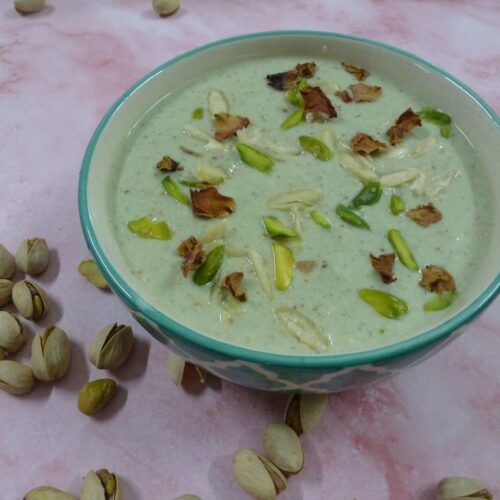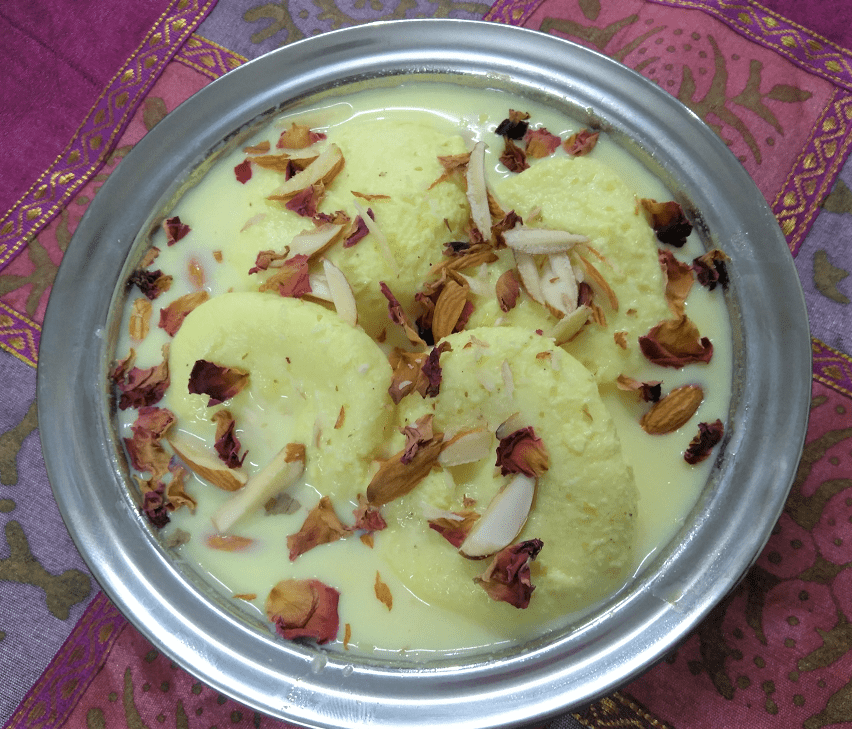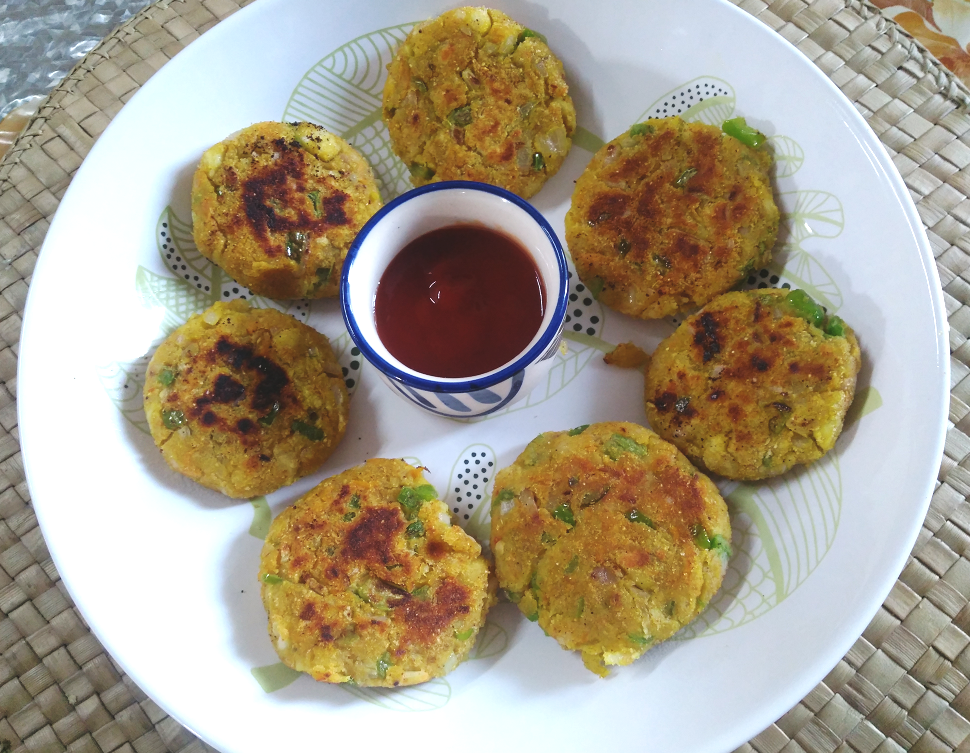Halwai Style Danedar Rose Pista Rabdi (rabri) is a famous North Indian sweet dish with a creamy grainy texture and a mild sweetness. It is made by simmering milk till it reduces to 1/3 to 1/4 of its original quantity. Very tempting with a unique taste, it is popularly served with Malpua, Gulab Jamun, Jalebi, and Shahi tukda.

What is Rabri or Rabdi?
Rabri or Rabdi is a milk-based dessert recipe from Indian cuisine. It is made by the thickening of full-fat milk on a low flame for a long time. Slow cooking of milk gives it a unique flavour and taste. The addition of blanched nuts enhances its flavour and gives crunchy bites.
Rabdi can be perfectly served at any occasion whether it is a festival or get-together or a kitty party. Serve it warm or chilled as per your choice.
Rabri texture can be made in two types one is with malai layers and the other with a plain creamy texture. I like most the plain one with a grainy and creamy texture. Later, in the post, I will share with you how you will get that halwai-style danedar (grainy) texture in your rabdi.
About Quick Rose Pista Rabdi Recipe
Traditionally, rabdi is made with whole full-fat milk to give it a perfectly rich and creamy taste & texture. Milk is added into a big vessel and simmered till it becomes one-third to one-fourth in quantity. The process of making this dish is long and time-consuming, but the end result is very yummy and delicious.
There are some other shortcut ways to make this delicious mouth-watering sweet dish. You can add condensed milk, milk powder, crumbled paneer, almond flour, or cashew powder to make it thick quickly.
Other milk based recipe you would like to try
In this post, I am sharing one of the short-cut methods to make a very yummy rose pista rabdi recipe at home. Most of the steps are similar to the traditional rabdi making except for the last step where we add milk powder, cornflour, pista and rose paste to the simmered milk to make it thick and give the desired flavour. The addition of cardamom powder and rose water brings it taste to the next level.

Few things that we keep in mind while making rabri. To make the process quicker, always use a wide-mouth heavy bottom pan to simmer the milk. A wide vessel helps in the fast evaporation of moisture from the milk and helps in thickening. I prefer to use my calphalon triple ply stainless steel pan for making this pista rabdi recipe. As it has to be cooked on low flame for a longer time heavy bottom pan helps in avoid any burning or sticking at the bottom. Stir it with a spatula every 8-10 minutes to avoid any sticking.
Pista Rabdi Ingredients
Milk – I have used full-fat Amul brand milk here but if you want to cut the calories replace it with toned milk. There is not a very detectable difference in the taste but if you want it more rich and creamy, full-fat milk is the right option.
Sugar– khandsari sugar is added in a small quantity. It is a healthier option to reduce white sugar consumption. The reduction of milk also added a sweet taste to this dish, if you want to skip sugar at all you can do so too.
Nuts– pistachio and dry rose petal mixture are used to give it a unique pista rose flavour. You can just add Kesar threads to give it a saffron flavour or any other flavour of your choice. Some blanched nuts are used for garnishing.
Colour– food grade green colour is used in a very small quantity to make it more attractive and a for a festive look. You can skip it if don’t want it.
FAQs
How to store rabdi?
Rabdi can be made in large quantities and stored in an air-tight container and refrigerated. It stays good for up to 3-4 days in the refrigerator. For longer storage, freeze them in 2-3 batches. So, whenever you want to eat you can take out a batch and defrost it without disturbing others.
How to serve rabdi?
Rabdi or rabri can be served warm or chilled as per your choice. It can be served with Malpua, Jalebi, Gulab Jamun, Shahi tukda or eaten as it is. You can add nuts and flavours to rabdi according to your taste.
What kind of pan is used for making rabdi?
Use a heavy bottom pan with wide mouth to fasten the thickening process and avoid sticking at the bottom.
How to Make Rose Pista Rabdi at Home-Step by Step Guide
1. Add toned milk (1 litre/4cups) to a heavy bottom pan or pot on medium heat. Keep 1/4 cup of milk separate in a bowl from this.
2. Once the milk is boiled, set the flame to the lowest setting. Stir the simmered milk every 8-10 minutes.


3. Now in a grinder jar add desi khand, dry rose petals, and pista. Grind them to make a powder. Keep it aside.


4. Add milk powder and corn flour in the milk separated and mix to form a lumps free mixture, keep it aside.


5. Cook and stirring the milk on low flame till the milk reduces to 1/2 of its quantity. It will take around 20-25 minutes.
6. Once it reaches this stage, add ground mixture of khand, rose petals, and pista. Also mixture of milk powder and corn flour and then cardamom powder. Mix well and cook it further for 2-3 minutes till the milk becomes little more thicker.


7. After that, add 1 pinch of citric acid and mix well. After a minute or two, milk becomes slightly grainy in texture.


8. Cook this further 2-3 minutes or for a thicker consistency 5-7 minutes.
9. Add rose water, mix well and switch off the flame. Now let it cool slightly and then add 1 drop of green colour(it is totally optional) and mix well.


10. Transfer the rose pista rabdi in a ceramic bowl and chill the rabri in the refrigerator. It becomes more thicker when cool down completely. Garnish with some blanched nuts and serve.
11. You can serve pista rabdi either chilled or warm.


Serving Suggestions
Serve this delicious rose pista rabdi as a dessert after a warm main course meal on any occasion. It goes perfectly with Gulab Jamun, jalebi or malpua. Serve it plain or with nuts for crunchy bites.
Tips and Tricks
- Once the milk is boiled, simmer it till it reduces to its 1/3 quantity.
- Stirring in between is very important to prevent any sticking at the bottom.
- Like rose pista flavour, you can add any flavour of your choice to give the rabdi a unique taste.
- For a more rich and creamy texture, use full-fat milk but keep in mind that it will also increase the calories.

Recipe Card

Halwai Style Danedar Rabri Recipe| Quick Rose Pista Rabdi
Ingredients
For making pista rose powder
- 3 tbsp desi khand
- 2 tbsp pista unsalted
- 2 tbsp dry rose petals
For making milk powder mixture
- 3 tbsp milk powder
- 1 tbsp corn flour
Other ingredients
- 1 litre full-fat milk
- ½ tsp cardamom powder
- 1 tsp rose water
- 1 pinch citric acid
- 1 drop food grade liquid green colour (optional)
- 2 tbsp almonds for garnishing
- 1 tbsp pista for garnishing
- 1 tbsp dry rose petals
Instructions
- Add toned milk (1 litre/4cups) to a heavy bottom pan or pot on medium heat. Keep 1/4 cup of milk separate in a bowl from this.
- Once the milk is boiled, set the flame to the lowest setting. Stir the simmered milk every 8-10 minutes.
- Meanwhile add some nuts to a bowl of boiling water and leave them for 10-15 minutes. I have used pista and almonds here, you can also use other nuts like cashews, raisins etc.
- Now in a grinder jar add khand and pista and grind them into a powder form. Keep it aside.
- Add milk powder and corn flour in the milk separated and mix to form a lumps free mixture, keep it aside.
- Keep doing this process till the milk reduces to 1/2 of its quantity. It will take around 20-25 minutes.
- Once it reaches this stage, add ground mixture of khand, rose petals, and pista. Also mixture of milk powder and corn flour and then cardamom powder. Mix well and cook it further for 2-3 minutes till the milk becomes little more thicker.
- Now, add 1 pinch of citric acid and mix well. After a minute or two, it becomes slightly grainy in texture.
- Cook this further 2-3 minutes or for a thicker consistency 5-7 minutes.
- Add rose water, mix well and switch off the flame. Now let it cool slightly and then add 1 drop of green colour(it is totally optional) and mix well.
- Transfer the rose pista rabdi in a ceramic bowl and chill the rabri in the refrigerator. It becomes more thicker when cool down completely. Garnish with some blanched nuts and serve.
- You can serve rabdi either chilled or warm.
Video
Notes
2. Stirring in between is very important to prevent any sticking at the bottom.
3. Like rose pista flavour, you can add any flavour of your choice to give the rabdi a unique taste.
4. For a more rich and creamy texture, use full-fat milk but keep in mind that it will also increase the calories.
My latest video
Try out this very yummy pista rabdi recipe. If you like the recipe share it with your friends and family and don’t forget to give us a 5 star rating. How it works for you, take a picture and tag it #healthicallykitchen on Instagram. Or, save it for later on Pinterest. I love to see them. Happy cooking!






